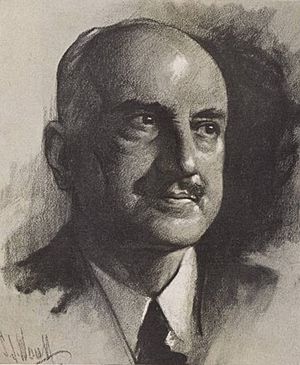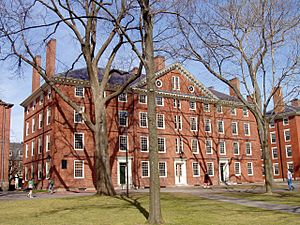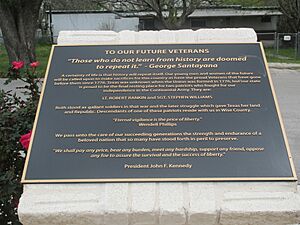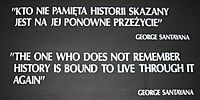George Santayana facts for kids
Quick facts for kids
George Santayana
|
|
|---|---|

A 1936 Time drawing of Santayana
|
|
| Born |
Jorge Agustín Nicolás Ruiz de Santayana y Borrás
December 16, 1863 Madrid, Spain
|
| Died | September 26, 1952 (aged 88) Rome, Italy
|
| Nationality | Spanish |
| Education | |
| Era | 20th-century philosophy |
| Region | Western philosophy |
| School | |
| Doctoral advisor | Josiah Royce |
| Notable students | Jacob Loewenberg, Conrad Aiken, T. S. Eliot, Horace Kallen, Walter Lippmann, W. E. B. Du Bois, Edward Rand, Alain Locke, Van Wyck Brooks, Learned Hand, Felix Frankfurter, Max Eastman, Gertrude Stein, Wallace Stevens |
|
Main interests
|
|
|
Notable ideas
|
|
|
Influences
|
|
|
Influenced
|
|
George Santayana (born Jorge Agustín Nicolás Ruiz de Santayana y Borrás; December 16, 1863 – September 26, 1952) was a famous philosopher, essay writer, poet, and novelist. He was born in Spain but moved to the United States when he was eight years old. He grew up and went to school in the US and thought of himself as an American. However, he always kept his Spanish passport. When he was 48, Santayana left his job at Harvard and moved back to Europe for good.
Santayana is well-known for his short, wise sayings called aphorisms. One of his most famous quotes is: "Those who cannot remember the past are condemned to repeat it." This means we should learn from history so we don't make the same mistakes again. Another quote is: "Only the dead have seen the end of war." Even though he didn't believe in God (he was an atheist), he still valued the Spanish Catholic traditions and ideas he grew up with.
Contents
Early Life in Spain and America
Santayana was born on December 16, 1863, in Madrid, Spain. He spent his early childhood in Ávila. His mother, Josefina Borrás, had promised her first husband that she would raise their children in the United States. So, in 1869, she moved back to Boston with her three children from that marriage.
Young Jorge, who was six years old, stayed with his father in Spain. In 1872, Jorge and his father also moved to Boston. But his father did not like Boston or his wife's way of life. He soon returned to Ávila, Spain, and lived there for the rest of his life. Jorge did not see his father again until he started college and began taking summer trips to Spain. Around this time, Jorge's first name was changed to George, which is the English version.
School Days and Learning

George Santayana went to Boston Latin School and then to Harvard College. At Harvard, he studied with important philosophers like William James and Josiah Royce. He was very active in many clubs, choosing them over sports. He started and led the Philosophical Club. He was also an editor and cartoonist for The Harvard Lampoon, a funny student magazine. He even helped start a literary magazine called The Harvard Monthly.
In 1886, he graduated from Harvard with top honors. After Harvard, Santayana studied in Berlin, Germany, for two years. He then came back to Harvard to finish his advanced degree in 1889. He became a professor at Harvard and taught there from 1889 to 1912. Many of his students became famous writers and thinkers, including T. S. Eliot, Robert Frost, and Gertrude Stein.
Life in Europe
In 1912, Santayana decided to leave his teaching job at Harvard. He wanted to spend the rest of his life in Europe. He had saved enough money and also received some money from his mother. After living in places like Ávila, Paris, and Oxford, he settled in Rome, Italy, after 1920. He lived there until he passed away.
During his 40 years in Europe, Santayana wrote 19 books. He was offered many important jobs at universities, but he turned them down. Many Americans visited him or wrote to him, including his assistant, Daniel Cory. Santayana became quite wealthy later in life. This was partly because his novel, The Last Puritan, published in 1935, became a surprise best-seller. He even used his money to help other writers, like Bertrand Russell.
Santayana's only novel, The Last Puritan, tells the story of a young man named Oliver Alden and how he grows up. His book Persons and Places is about his own life. These books also contain many of his clever ideas and witty remarks. He wrote about many different topics, such as philosophy, books, history, politics, and how religion affects culture. He always wrote with a lot of humor and intelligence.
Even though some of his philosophical writings can be hard to understand, his other books are easier to read and full of interesting thoughts. He also wrote poems and plays, and many of his letters have been published. Santayana observed American culture like an outsider, similar to Alexis de Tocqueville. He wrote about philosophy in a very literary way, much like his friend and mentor, William James. Santayana is usually thought of as an American writer, even though he never became an American citizen. He spent his last ten years in Rome, cared for by Catholic nuns. He passed away in September 1952 and was buried in the Spanish section of the Campo Verano cemetery in Rome.
Main Ideas and Books
Santayana's most important philosophical books include The Sense of Beauty (1896), which was one of the first major books on aesthetics (the study of beauty) written in the United States. Another big work was The Life of Reason (5 volumes, 1905–06), which was a highlight of his time at Harvard. He also wrote Scepticism and Animal Faith (1923) and The Realms of Being (4 volumes, 1927–40).
Santayana believed that human thinking, cultural practices, and social groups developed over time to fit in with their surroundings. He thought their value could be judged by how much they helped people be happy. He also admired the ideas of ancient thinkers like Democritus and Lucretius, who believed that everything is made of matter. He greatly respected the writings of Spinoza, calling him his "master and model."
Even though he was an atheist, Santayana had a positive view of religion. He called himself an "aesthetic Catholic," meaning he appreciated the beauty and traditions of Catholicism, even if he didn't believe in its religious teachings. His thoughts on religion can be found in his books Reason in Religion and Interpretations of Poetry and Religion.
His Lasting Influence
George Santayana is mostly remembered for his many famous sayings, which are often repeated. His ideas influenced many people, including other philosophers and writers. For example, he influenced Bertrand Russell and many of his students at Harvard, like T. S. Eliot, Robert Frost, and Gertrude Stein. The poet Wallace Stevens was also a friend and was especially influenced by Santayana's ideas about beauty.
The sociologist Erving Goffman was inspired by Santayana's ideas for his famous book The Presentation of Self in Everyday Life. The mathematician and philosopher Alfred North Whitehead also quoted Santayana a lot in his major work Process and Reality.
The famous cartoonist Chuck Jones used Santayana's description of fanaticism as "redoubling your effort after you've forgotten your aim" to describe his cartoons about Wile E. Coyote and the Road Runner.

Awards
- Royal Society of Literature Benson Medal, 1925.
- Columbia University Butler Gold Medal, 1945.
- Honorary degree from the University of Wisconsin, 1911.
See also
 In Spanish: George Santayana para niños
In Spanish: George Santayana para niños




